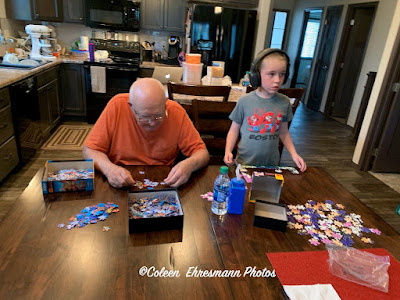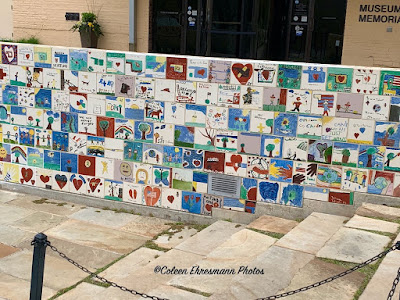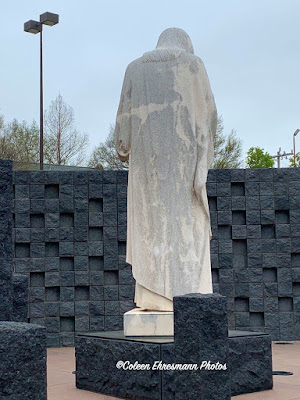"On April 19, 1995, Timothy McVeigh parked a Ryder rental truck filled with explosives in front of the Alfred P. Murrah Federal Building. The resulting explosion killed 168 people and destroyed the entire north face of the building.
On October 1997, President Bill Clinton signed law creating the Oklahoma City National Memorial as a unit of the National Park Service to be operated by the Oklahoma City National Memorial Trust. The total cost of the memorial was $29.1 million. The federal government appropriated $5 million for the construction with the state of Oklahoma matching that amount. More than $17 million in private donations was raised." ~Wikipedia
This was our second visit to the memorial.
(We were there in 2016) This time, because of geocaching, we took the time to wander throughout the memorial grounds, reading information, and processing the reason for the memorial. Because of the coronavirus, there were very few people in downtown Oklahoma City and even fewer at the memorial. This year was to be the 25th anniversary of the bombing.
The Survivor Tree
This American elm stood just yards away from the explosion and shouldn't have survived the blast. However, this amazing tree not only survived, but it still thrives today. Hundreds of seeds from this tree are planted annually and the resulting saplings are distributed each year on the anniversary of the bombing. Thousands of Survivor Trees are growing in public and private places all over the US. The Survivor Tree is a symbol of hope and resilience for the community.
Rescuers' Orchard
"A grove of Oklahoma redbuds, Amur Maple, Chinese Pistachio, and Bosque Elm trees are planted on the lawn around the Survivor Tree. The trees represent the rescuers who came to the aid of the survivors; hence the rescuer's orchard surrounds the survivor tree. The non-native species represent those rescuers who came from outside Oklahoma to help." ~ Wikipedia
Reflecting Pool
"A thin layer of water flows over polished black granite to form the pool, which runs east to west down the center of the Memorial on what was once Fifth Street. Although the pool is flowing, visitors are able to see a mirror image of themselves in the water." ~Wikipedia
Field of Empty Chairs
The Field of Chairs contains 168 empty chairs handcrafted from glass, bronze, and stone representing those who lost their lives, with a name etched in the glass base of each.
The chairs are arranged in nine rows to symbolize the nine floors of the building; each person's chair is on the row (floor) on which the person worked or was located when the bomb exploded.
Nineteen smaller chairs represent the children killed in the bombing. Three unborn children died along with their mothers, and they are listed on their mothers' chairs beneath their mother's names.
The Survivors' Wall
"The only remaining original portions of the Murrah Building are the north and east walls, known as the Survivors' Wall. The wall has several panels of granite salvaged from the Murrah Building [lobby], inscribed with the names of more than 600 survivors from the building and surrounding area, many of whom were injured in the blast." ~Wikipedia
Oklahoma City National Museum
On the north side of the memorial is the museum, formerly The Journal Record. It now features numerous exhibits and artifacts related to the bombing.
Children's Area
Nestled in the Rescuer's Orchard "more than 5000 hand-painted tiles, from all over the US and Canada, were made by children and sent to Oklahoma City after the bombing in 1995. Most are stored in the memorial's Archives, and a sampling of tiles is on the wall in the Children's Area." ~Wikipedia
replicas of some of the tiles
The Memorial Fence
"A 10-foot-tall chain link fence was installed around the area that is now the Reflecting Pool and the Field of Empty Chairs to protect the site from damage and visitors from injury. The Fence stood for more than four years, becoming notable as the place where visitors left stuffed animals, poems, keychains, and other items as tributes. During the construction of the Outdoor Memorial, 210 feet of the Fence was moved to the west side of the Memorial, along the 9:03 side or the 'healing' side. The remainder of the Fence is in storage. Visitors may still leave small items along the Fence; the mementos are periodically collected, cataloged, and stored." ~ Wikipedia
And Jesus Wept
"Across the street from the 9:03 gate is the sculpture of Jesus weeping erected by St. Joseph's Catholic Church, one of the first brick-and-mortar churches built in the city. Jesus faces away from the devastation, covering his face with his hand. In front of Jesus is a wall with 168 gaps in it, representing the voids left by each life lost." ~Wikipedia
Nineteen black granite pillars of varying heights are on the steps and platform of the statue. They represent the nineteen children lost in the bombing.
St. Joseph Old Cathedral was severely damaged by the bombing and had to be extensively repaired, while the old parish rectory had to be demolished. The statue was erected in the place of the old rectory.
Paul Meyer is the architect for this statue and memorial area
(click on the photo to enlarge it to see the detail in the statue)
The Gates of Time
Twin bronze gates frame the moment of destruction (9:02) and mark the formal entrances to the Outdoor Memorial. This is the eastern gate, representing the last moments of peace at 9:01. The western gate marks the moment of recovery, 9:03.
We come here to remember Those who were killed, those who survived and those changed forever. May all who leave here know the impact of violence. May this memorial offer comfort, strength, peace, hope and serenity.
The first part of the memorial was dedicated on April 19, 2000 on the five year anniversary of the bombing. The Memorial Museum was dedicated on February 19, 2001. Over 4.4 million visitors have been to the memorial since its opening. It averages 350,000 visitors a year.






















































